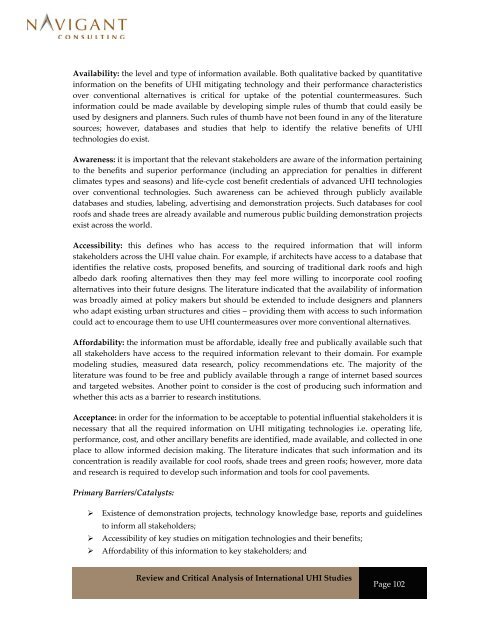Review and Critical Analysis of International UHI Studies
Review and Critical Analysis of International UHI Studies
Review and Critical Analysis of International UHI Studies
You also want an ePaper? Increase the reach of your titles
YUMPU automatically turns print PDFs into web optimized ePapers that Google loves.
Availability: the level <strong>and</strong> type <strong>of</strong> information available. Both qualitative backed by quantitative<br />
information on the benefits <strong>of</strong> <strong>UHI</strong> mitigating technology <strong>and</strong> their performance characteristics<br />
over conventional alternatives is critical for uptake <strong>of</strong> the potential countermeasures. Such<br />
information could be made available by developing simple rules <strong>of</strong> thumb that could easily be<br />
used by designers <strong>and</strong> planners. Such rules <strong>of</strong> thumb have not been found in any <strong>of</strong> the literature<br />
sources; however, databases <strong>and</strong> studies that help to identify the relative benefits <strong>of</strong> <strong>UHI</strong><br />
technologies do exist.<br />
Awareness: it is important that the relevant stakeholders are aware <strong>of</strong> the information pertaining<br />
to the benefits <strong>and</strong> superior performance (including an appreciation for penalties in different<br />
climates types <strong>and</strong> seasons) <strong>and</strong> life‐cycle cost benefit credentials <strong>of</strong> advanced <strong>UHI</strong> technologies<br />
over conventional technologies. Such awareness can be achieved through publicly available<br />
databases <strong>and</strong> studies, labeling, advertising <strong>and</strong> demonstration projects. Such databases for cool<br />
ro<strong>of</strong>s <strong>and</strong> shade trees are already available <strong>and</strong> numerous public building demonstration projects<br />
exist across the world.<br />
Accessibility: this defines who has access to the required information that will inform<br />
stakeholders across the <strong>UHI</strong> value chain. For example, if architects have access to a database that<br />
identifies the relative costs, proposed benefits, <strong>and</strong> sourcing <strong>of</strong> traditional dark ro<strong>of</strong>s <strong>and</strong> high<br />
albedo dark ro<strong>of</strong>ing alternatives then they may feel more willing to incorporate cool ro<strong>of</strong>ing<br />
alternatives into their future designs. The literature indicated that the availability <strong>of</strong> information<br />
was broadly aimed at policy makers but should be extended to include designers <strong>and</strong> planners<br />
who adapt existing urban structures <strong>and</strong> cities – providing them with access to such information<br />
could act to encourage them to use <strong>UHI</strong> countermeasures over more conventional alternatives.<br />
Affordability: the information must be affordable, ideally free <strong>and</strong> publically available such that<br />
all stakeholders have access to the required information relevant to their domain. For example<br />
modeling studies, measured data research, policy recommendations etc. The majority <strong>of</strong> the<br />
literature was found to be free <strong>and</strong> publicly available through a range <strong>of</strong> internet based sources<br />
<strong>and</strong> targeted websites. Another point to consider is the cost <strong>of</strong> producing such information <strong>and</strong><br />
whether this acts as a barrier to research institutions.<br />
Acceptance: in order for the information to be acceptable to potential influential stakeholders it is<br />
necessary that all the required information on <strong>UHI</strong> mitigating technologies i.e. operating life,<br />
performance, cost, <strong>and</strong> other ancillary benefits are identified, made available, <strong>and</strong> collected in one<br />
place to allow informed decision making. The literature indicates that such information <strong>and</strong> its<br />
concentration is readily available for cool ro<strong>of</strong>s, shade trees <strong>and</strong> green ro<strong>of</strong>s; however, more data<br />
<strong>and</strong> research is required to develop such information <strong>and</strong> tools for cool pavements.<br />
Primary Barriers/Catalysts:<br />
� Existence <strong>of</strong> demonstration projects, technology knowledge base, reports <strong>and</strong> guidelines<br />
to inform all stakeholders;<br />
� Accessibility <strong>of</strong> key studies on mitigation technologies <strong>and</strong> their benefits;<br />
� Affordability <strong>of</strong> this information to key stakeholders; <strong>and</strong><br />
<strong>Review</strong> <strong>and</strong> <strong>Critical</strong> <strong>Analysis</strong> <strong>of</strong> <strong>International</strong> <strong>UHI</strong> <strong>Studies</strong><br />
Page 102


